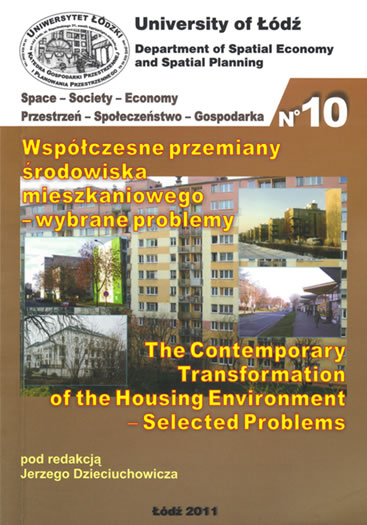POCZUCIE BEZPIECZEŃSTWA W ŁODZI. PRZYKŁAD BADAŃ MIESZKAŃCÓW OSIEDLI MIESZKANIOWYCH
DOI:
https://doi.org/10.18778/1733-3180.10.08Słowa kluczowe:
Łódź, warunki mieszkaniowe, poczucie bezpieczeństwa, przestępczośćAbstrakt
This article consists of two parts: short theoretical admission and the main, empirical part. The main part presents the analysis of the level of fear of crime, the factors that influence it and characteristics of the prevalence in recorded crime of five selected housing estates: D browa (block housing estate mainly dates from 1970−75 years), Jagiełły-Czarnieckiego (building dates from the years 1975−80), Karolew (blocks from the second half of the sixties), Kurak (older buildings were designed for habitation before the 1965 year) and Widzew-Wschód (housing estate was built in the eighties). The author analyzes research results regarding three main aspects of the sense of security: cognitive (What is the likelihood that you will become a victim of offence?, What is the likelihood that you will become a victim of one of the forms of offence mentioned below (such: beaten, robbed, assaulted, molested etc)?), emotional (How often do you usually walk alone in this area after dark?) and behavioural (active/passive forms of protection). As well socio-demographic factors of residents that influence the level of fear were studied. In five research areas, respondents assessed the dangers and threats in their neighbourhood in a different way but there are not identified any significant spatial variations in sense of security. On the other hand, there are many interesting correlations between three main components of the fear of crime and between components and certain socio-demographic respondent’s characteristics as well. The survey also confirmed a lack of correlation between the sense of security and the real level of recorded crime.
Pobrania
Bibliografia
Aronson E., Wilson T., Akert R., 2007, Psychologia społeczna, Wyd. Zysk i S-ka, Poznań.
Google Scholar
Błachut J., Gaberle A., Krajewski K., 1999, Kryminologia, Gdańsk.
Google Scholar
Dzieciuchowicz J., 2005, Spółdzielcze budownictwo mieszkaniowe w Łodzi − struktura i typologia przestrzenna, „Acta Universitatis Lodziensis. Folia Geographica Socio-Oeconomica”, nr 6.
Google Scholar
Felisiak M., 2009, Poczucie bezpieczeństwa i opinie o pracy policji, Komunikat z badań CBOS, Warszawa.
Google Scholar
Foland A., Górecki J., 2007, Percepcja zagrożenia przestępczością w Krakowie. Przykład zastosowania metody psychokartograficznej, [w:] Nowe pola badawcze, ujęcia teoretyczne i metody w polskiej geografii, red. J. Górecki, I. Kawecka, Kraków.
Google Scholar
Hołyst B., Kube E., 1995, Strach przed przestępczością − zaniedbany problem polityki kryminalnej, „Prokuratura i Prawo”, nr 1.
Google Scholar
Krajewski K. (red.), 2008, Poczucie bezpieczeństwa mieszkańców wielkich miast. Kraków na tle innych miast europejskich, Kraków.
Google Scholar
Osiecka J., 1998, Poczucie zagrożenia przestępczością oraz społeczne opinie o policji w świetle sondaży opinii publicznej, Raport Biura Studiów i Ekspertyz, 151.
Google Scholar
Strzeszewski M., 2007, Czy na co dzień czujemy się bezpiecznie?, Komunikat z badań CBOS, Warszawa.
Google Scholar
Pobrania
Opublikowane
Jak cytować
Numer
Dział
Licencja

Praca jest udostępniana na licencji Creative Commons Attribution-NonCommercial-NoDerivatives 3.0 Unported License.









